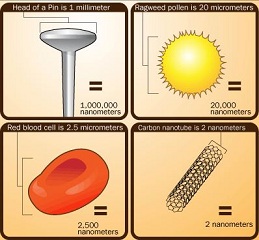|
Titanium dioxide sunscreen – the nano-technology controversy
Obviously, the largest use of titanium dioxide is in paints, especially in white paint, so large that the pigment gave name to a particular nuance – titanium white. In paints, titanium oxide based pigments have the advantages of giving the most opaque white possible with great covering power. This is not such a good thing when used in titanium dioxide sunscreens, as the opaqueness effect translates in a whitey layer that is anywhere near beautiful, especially when applied on some long, smooth silky legs. 
Sorry, I got carried away for a little bit here. Anyway, the idea is that the manufacturers of sunscreens, and other cosmetically products that use titanium dioxide, and they are a lot, began researching for possibilities of reducing this side effect. The answer was soon discovered in nano-particles. This is a modern way of breaking raw substances down pieces that have dimensions that are measured between 1 and 100 nanometers. 1 meter is one million nanometers. To have a visual understanding of this size, imagine that a strain of hair is about 100000 nanometers wide. On the other hand a single water molecule is less than 1 nanometer in diameter. Thus, nano-particles are something in between atomic and molecular dimensions and pure bulk material. Seemed like a perfect solution. At least for a while. Because nano-particles display some properties that are not necessarily met in the source material when is sized in larger pieces. It has been observed that the properties of materials change as their size approaches the nanoscale and as the percentage of atoms at the surface of a material becomes significant. For bulk materials larger than one micrometer (or micron), the percentage of atoms at the surface is insignificant in relation to the number of atoms in the bulk of the material. The interesting and sometimes unexpected properties of nanoparticles are therefore largely due to the large surface area of the material, which dominates the contributions made by the small bulk of the material. It is this last surface area property that was the basis for the controversial mice test that ignited the current titanium dioxide sunscreen controversy. Titanium, and by extension, titanium dioxide, is, indeed physiologically inert. However, when the particles become progressively smaller, their surface, in turn, becomes progressively bigger and in the interaction of this surface with the environment oxidative stress is induced. Oxidative stress is some modern medical term that spells out for the non-initiate “possibly increases the risk of cancer cells”. The study was conducted by the UCLA's Jonsson Comprehensive Cancer Center. The mice were exposed to the TiO2 nanoparticles in their drinking water. Once in the system, it was revealed that they accumulated in different organs because the test body had no way to eliminating them. It is speculated that the same effect that was studied in mice, could also be possible in humans. However, the human equivalent would only occur at about 2 years of exposure to titanium nanoparticles in a manufacturing environment. It was not certainly established if regular, everyday exposure increases exponentially as continued contact with the titanium dioxide occurs over time. The test also demonstrated that titanium nanoparticles cannot go through skin, so lotion based titanium dioxide sunscreen are safe, unless ingested, of course. On the other hand, spray-on sunscreens could potentially be inhaled and the nanoparticles could enter the body via lungs. Not to mention, the thousands food products that use titanium dioxide as a pigment. However, usually, in food industry titanium dioxide is rarely, if ever, used in nano sizes. The manufacture of TiO2 nanoparticles has become a huge industry, with a global output estimated at around two million tons per year. It is clear that only one, hardly conclusive test, is not sufficient to abruptly put an end to all this. And the industry has quickly adapted by use of micronized particles, which are larger than nano-particles, thus removing the already unlikely negative effects.
Return from Titanium dioxide sunscreen to Titanium Dioxide Return to Titanium Exposed Home Page
|

